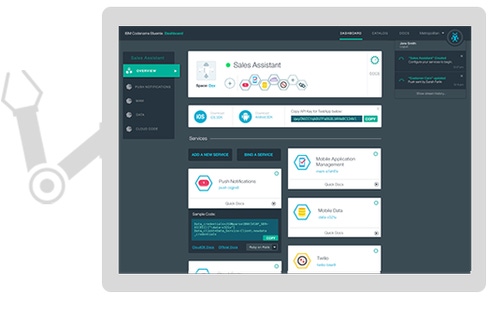IBM Bluemix Gets DevOps Muscle
IBM refreshes its Bluemix platform-as-a-service in a bid to attract more agile and DevOps developers for its SoftLayer unit.

IBM is beefing up its Bluemix platform-as-a-service, relying on decades of software development expertise in an attempt to muscle into this developer-oriented form of cloud computing. If it can attract more developers to its SoftLayer unit, then it's likely to find more enterprise applications deployed on that same platform.
Bluemix is a set of tools, languages, application services, and "Boilerplates" on top of an IBM-specific version of Cloud Foundry that runs on SoftLayer infrastructure. Cloud Foundry is open source PaaS, launched by VMware spin-off Pivotal, and now independently governed by its own foundation. It runs on Amazon Web Services, but there is a downloadable version that IBM has installed on its own SoftLayer cloud unit.
Bluemix in the SoftLayer setting provides seven Boilerplates, basic application formats geared to different purposes. With a Bluemix "Mobile Boilerplate," a developer can have a skeleton of a mobile application up and running in a few minutes. It will have the ability to push updates to a class of devices, access backend services, manage data persistence as it moves from database servers to the device, and maintain operational security. All the developer needs to do is fill in the device-specific code needed for the service results to appear on a particular end-user device, says Daniel Sabbah, CTO and general manager of IBM's next-generation platform.
Bluemix also provides developers with team-oriented Rational and other development tools. It offers a wide selection of languages, from standard Java to Node.js, JavaScript, Python, Ruby, and PHP.
[Want to learn more about the launch of Bluemix? See IBM Bluemix PaaS Play Explained.]
"I started Bluemix 18 months ago," says Sabbah in an interview ahead of Monday's announcement of the enhancements. His plan wasn't just to match what other platforms can do, such as Salesforce.com's own Force.com, Salesforce's Heroku on AWS, or the independent EngineYard, also on AWS. Instead, he wanted to bring together a set of services that would give Bluemix its own agile and unique DevOps flavor.
"I was put in this job in order to start delivering a richer, cloud-based environment," he says. His experience as a former GM of the IBM/Rational tools business, GM of Tivoli, and CTO of the IBM Software Group for three years put him in a position to do so.
He has been a programmer himself in a variety of languages throughout much of his 40 years at IBM. "We've woven in a DevOps environment for development teams," he says of the revised Bluemix. The development processes include simplified testing, fast access to test results and feedback, and automated management of code changes and builds.
In addition, Bluemix can provide:
AppScan, a rapid testing for code security before it's launched into different environments.
Embeddable Reporting, to give an app advanced analytics for big data the moment it's launched.
Continuous Delivery Pipeline, a DevOps feature that installs a strict process for frequent production updates and simultaneous release of multiple applications.
Many of the Bluemix services are running continuously in the SoftLayer cloud. They can be accessed through an API by the logic of the application. There are a total of 30 application services and seven Boilerplate application formats available, Sabbah says. In addition, many open source systems, such as Hadoop, MongoDB, RabbitMQ messaging, and Memcache are also available. But the systems all assume deployment to IBM's SoftLayer cloud infrastructure.
One advanced feature is an Internet of Things service that can recognize the messaging protocol of many types of devices. Once a customer notifies the service of the type of device, it can set up an account to receive that type of message from the customer's devices, where they can be stored and analyzed on a system of the customer's choice, such as Hadoop or a NoSQL system. The service can manage the pace at which the messages are collected, he says.
What do Uber, Bank of America, and Walgreens have to do with your mobile app strategy? Find out in the new Maximizing Mobility issue of InformationWeek Tech Digest.
About the Author(s)
You May Also Like







